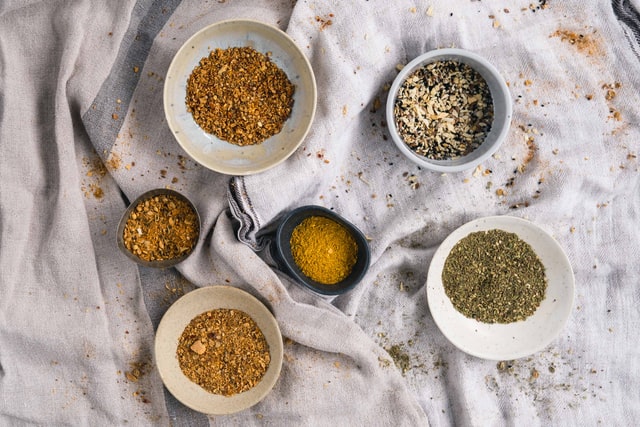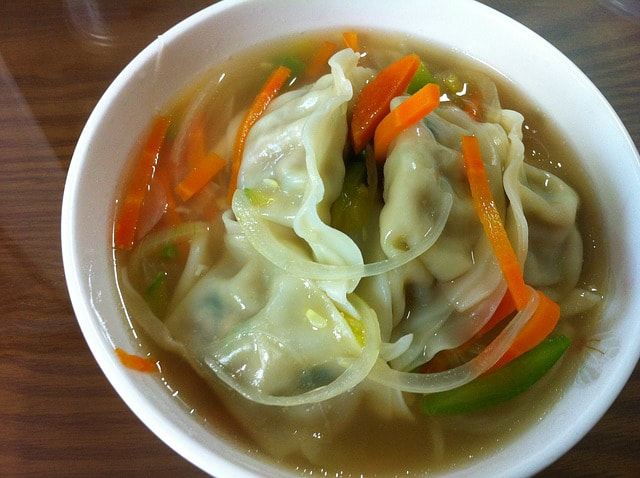|
1/29/2020 Indian spices
Indian food is, of course, unimaginable without spices. The complex, multilayered flavours associated with the best Indian food are achieved through careful cooking and the artful combination of usually small amounts of several different spices. In music, single notes are played in combination to form chords - a harmonious melding of the separate elements to form a rich whole. Used correctly, spices can work in the same way, striking their own note yet contributing to an overall, complex effect that is somehow more than the sum of its parts. Which particular spices are used and how they're cooked will vary slightly depending on the dish and the region from which the dish originates. But throughout India, you'll find the same basic spices used over and over again; at first you'd think that this would mean that all dishes end up tasting the same but, in fact, even a subtle variation in the balance of quantities of each spice, or the method by which the spices are tempered (see pages 12-14) can make a striking difference to the finished flavour. The beauty of home cookingYou may have eaten in an Indian restaurant and been disappointed to find the flavours in the meat, fish and vegetable dishes to be very similar - it is not unknown for restaurants to have a ready-prepared masala which they use as the base for all their dishes. This approach, however, cannot result in anything but unremarkable dishes - one spice balance is not going to suit all foods. This is where home cooking wins over mass production every time: an experienced cook like Rose can tailor the masala for each dish specifically to achieve a fine balance between the flavour of the spices and what should be the 'star' of the dish - the main component, be it vegetables, meat or fish. Spice shoppingSurprisingly, a relatively limited palette of core spices is all you need to cook a huge variety of dishes. Alongside a selection of whole spices, seeds and ground spices (see overleaf), we use two spice blends frequently - garam masala and dhana jiru. Both can be bought ready-ground but, in the case of garam masala, I'd urge you to steer well clear of proprietary blends: they tend to lack character (in aiming to offend no one they also fail to excite). You'll have better results if you take the time to make your own - follow the recipe on page 17. Dhana jiru, a classic Indian blend that's used widely, can be surprisingly tricky to get hold of, so we've included a recipe for it too (see overleaf).
We also use two other spice blends in some of our recipes, and these are ready-made blends: hot Madras curry powder and tandoori masala. When our recipes use ready-made spice blends, we tend to throw in other pure spices: the blandness of bought spice blends can be successfully alleviated by deft customisation. Be very fussy about what you buy. Look for Indian blends (and do check the ingredients don't include alien items such as monosodium glutamate, maize starch, and artificial colours or preservatives). Find a brand you like and stick with it. Always buy small quantities and use up your stock quickly so that it remains fresh." -from Cooking with my Indian mother-in-law by Simon Daley (with Roshan Hirani) 1/14/2020 Pork Soup Dumplings
These dumplings are filled with a mixture of ground pork, finely chopped shrimp, and chilled chicken soup aspic. When the dumplings are steamed, the aspic melts - as my friend Val says, the soup is in the dumpling, not the other way around! Note that the stock has to be reduced and then chilled overnight to become gelatinous before you make the dumplings. When you are ready to fill them, you'll find that they're the kind of project you want to take on with the help of friends or family, preferably with good music in the background. All the work is more than repaid by the great meal that results. These don't freeze well, so invite lots of friends to feast with you.
Makes 75 to 100 Dumplings 1 recipe Chinese Chicken Super Stock (see page 308) 16 peeled pastured chicken feet or 2 envelopes gelatin 1/4 pound peeled raw shrimp, very finely chopped 1 pound ground pastured pork 1 bunch scallions (white part only) finely chopped 2 tablespoons sugar 2 tablespoons soy sauce 1 clove garlic, finely chopped 1/2 teaspoon kosher salt Freshly ground black pepper 1/2 teaspoon grated peeled fresh ginger 1/2 teaspoon Chinese rice win (Shaoxing wine) 1/4 teaspoon dark sesame oil 2 packages dumpling or Gyoza skins (not wonton skins) 6 whole Napa cabbage leaves, plus more as needed For the dipping sauce: 1/2 cup Chinese black vinegar 1 tablespoon finely grated peeled fresh ginger In a pot over medium heat, cook the chicken stock down. If you have chicken feet, first cook them with the stock over low heat for several hours, then proceed to reduce the stock by half. If you are using gelatin, cook until the stock has been reduced to 2 cups, then sprinkle the surface of the hot stock with the gelatin and stir to dissolve. Pour the stock into a 5- to 6-cup shallow refrigerator storage container (removing the chicken feet if you used them) and refrigerate overnight. The next day, invert the gelatin over a cutting board and slice it into 1/4-inch squares. Set these aside. Combine the shrimp, pork, scallions, sugar, soy sauce, garlic, salt, pepper, ginger, rice wine, and seame oil in a large bowl; mix well. Fold in the aspic cubes, taking care not to break them. Take out a dumpling skin and drape the rest of the package with a damp tea towel. Line 2 sheet pans with parchment paper, and set out a small bowl of water and a little paintbrush or pastry brush. Place a dumpling skin in the palm of your hand and paint the edges with water. Put about 1 teaspoon filling in the center of the dough and make sure the dumpling contains 3 or 4 cubes of aspic. Draw the edges of the dough up around the filling, and roughly pleat them to form a package, leaving a tiny hole where the dough edges come together (this is supposed to prevent the dumpling from exploding while it cooks - I have never had that happen, so the ventilation hole must work). The dumpling should look like a squat little drawstring purse. Set it on the parchment, pleated side up, and repeat until you have used up all the filling. Line a steamer with 3 of the Napa cabbage leaves and bring to a boil. Put in as many dumplings as can fit without touching, and steam for 10 minutes per batch, starting the timing when the water boils. Add new cabbage if necessary for later batches. Combine the vinegar with the ginger to make the dipping sauce, and pass this alongside the platter of hot soup dumplings." - "Good Meat: The Complete Guide to Sourcing and Cooking Sustainable Meat," by Deborah Krasner |
Archives
November 2020
Categories |


